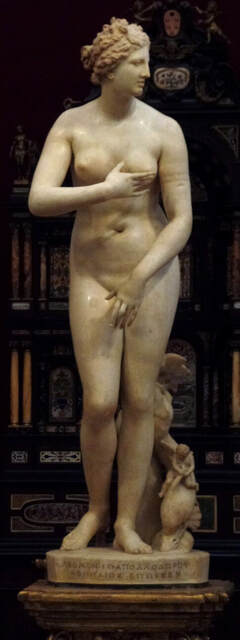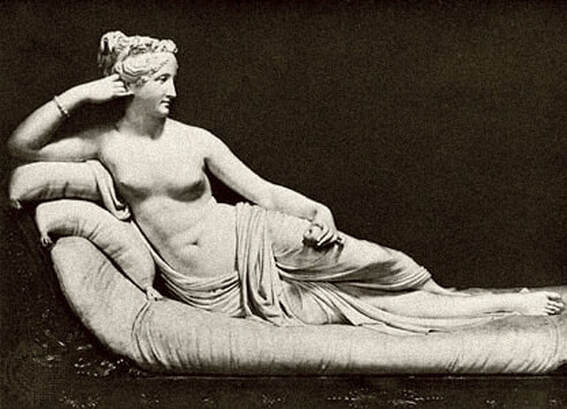|
Wai Laam Lo, CC BY-SA 3.0
Where? Room 18 of the Uffizi Museum
When? Between the third and first century before Christ Commissioned by? Unknown What do you see? A life-size marble statue (about five feet tall or 155cm) of the Greek goddess Venus. At her feet is Cupid (the god of Desire, erotic love, attraction, and affection) riding a dolphin. Venus is depicted in a fugitive pose after arising from the sea. The statue was considered one of the most erotic statues in the world due to her almost perfectly sculpted buttocks (which you cannot see, unfortunately). While her arms are partly covering her breasts and pubic area, it actually draws the attention to these parts of her body. Backstory: The origins of this statue are unknown, and thus we don’t know who sculpted her. It is the oldest statue in the Uffizi and is referred to as Venus de’ Medici because the Medici family acquired it in 1677. The statue was initially displayed in Rome, but Pope Innocent XI decided that it should be moved to Florence. Pope Innocent XI was a deeply religious man and decided that such a notorious naked statue did not belong in Rome. The statue was originally colored. However, over time the statue lost its color and experts thought that the colors were not part of the original. So, in the 18th-century acids were used to remove the last traces of color from the statue. Recent microscopic research has shown that the statue was colored originally. The original color of her hair was gold, she had red lips and her ears were pierced for earrings. This marble statue is a copy of an original Greek statue of Venus in bronze. The Venus De’ Medici is one of the most copied statues of all time (for example, there is one in the Metropolitan Museum of Art in New York). Interestingly, the Venus de’ Medici, with Cupid riding a dolphin is not tied to any known mythological story, which adds to the fascination and speculation about this statue. Symbolism: The size of Venus is enormous compared to the small Cupid and the dolphin at her feet to give the impression that Venus is giant. The somewhat apologetic pose of Venus (covering her breasts and pubic area) and the dolphin at her feet make it likely that she got somewhat surprised when arising from the sea. Who is Venus? Venus is the Roman goddess of love, beauty, sex, fertility, prosperity, and desire. Venus is also known in the Greek mythology as Aphrodite. Together with the Mars, the god of war, she is the parent of Cupid. The ancient Romans also considered Venus as the goddess of the gardens, and this makes her a popular subject for statues placed in gardens. Over time many statues have been made of Venus, often as an excuse to depict nudity. A well-known example is the Venus Victrix of Antonio Canova which can be admired nowadays in the Galleria Borghese in Rome.
Why Venus? Venus was admired by the Romans and Greeks as she represented love and sexuality. This statue of Venus was heavily inspired by the life-size statue Aphrodite of Cnidus (or Knidos), a famous statue from the fourth century before Christ. These life-size statues of a naked Venus were considered to be very attractive to men in ancient times.
Fun fact: The statue has an inscription at its base reading ‘CLEOMENES SON OF APOLLODORUS OF ATHENS’. However, this inscription is not original as the base with the inscription was broken. The current inscription was added to it in the 17th century. It seems highly unlikely that Cleomenes created this sculpture as he was not a very good sculptor. In the 17th and 18th century it was common practice to add the name of Cleomenes to statues of mediocre quality to enhance the value of those statues. The Venus de’ Medici sculpture, however, is more in line with the work of Praxiteles who created very elegant and graceful statues around the time that this statue was made, but there is not much other evidence to confirm this.
Written by Eelco Kappe
1 Comment
Ron
7/7/2018 05:02:42 am
"The Beauty comes, and had I tongues of fire,
Reply
Leave a Reply. |
Categories
All
|
- Home
- Blog
-
Museums
- Alte Pinakothek
- Art Institute of Chicago
- Baltimore Museum of Art
- Barber Institute of Fine Arts
- Bargello
- Barnes Foundation
- British Museum
- Church of Sant’Anastasia
- Cleveland Museum of Art
- Courtauld Institute of Art
- Detroit Institute of Arts
- Frans Hals Museum
- Galleria Borghese
- Gallerie dell'Accademia
- Getty Museum
- Guggenheim
- Hermitage Museum
- Kunsthistorisches Museum
- Kunstmuseum Basel
- Legion of Honor Museum
- Louvre
- Mauritshuis
- Metropolitan Museum of Art
- Musee d’Orsay
- Museum of Fine Arts in Boston
- Museum of Modern Art
- National Gallery in London
- National Gallery of Art
- National Museum in Poznań
- Norton Simon Museum
- Ny Carlsberg Glyptotek
- Palace of Versailles
- Palazzo Pitti
- Palazzo Vecchio
- Petit Palais
- Philadelphia Museum of Art
- Prado
- Pushkin Museum
- Ravenna Art Museum
- Rijksmuseum
- San Diego Museum of Art
- Santa Maria delle Grazie
- St. Peter's Basilica
- Städel Museum
- Statens Museum for Kunst
- Tate Britain
- Tate Modern
- Timken Museum of Art
- Uffizi
- Vatican Museums
- Wallace Collection
-
Artists
- Altdorfer
- Anguissola
- Berlin Painter
- Bosch
- Botticelli
- Boucher
- Bronzino
- Bruegel the Elder
- Brunelleschi
- Cabanel
- Caillebotte
- Canova
- Caravaggio
- Carpeaux
- Cezanne
- Cimabue
- David
- Degas
- Delacroix
- De Maria
- Donatello
- El Greco
- Fontana
- Fra Angelico
- Fragonard
- Gauguin
- Gentileschi
- Gericault
- Gonzalez-Torres
- Goya
- Hals
- Hogarth
- Hokusai
- Ingres
- Leonardo da Vinci
- Lippi, Filippo
- Longhi, Barbara
- Lorrain
- Makovsky
- Manet
- Massys
- Matisse
- Merian
- Michelangelo
- Mochi
- Modigliani
- Monet
- Panini
- Parmigianino
- Perugino
- Picasso
- Pisanello
- Raphael
- Rembrandt
- Renoir
- Reynolds
- Rivera
- Rodin
- Rubens
- Scultori
- Seurat
- Steen
- Tintoretto
- Titian
- Toulouse-Lautrec
- Turner
- Uccello
- Van der Weyden
- Van Dyck
- Van Eyck
- Van Gogh
- Van Hemessen
- Vasari
- Velazquez
- Vermeer
- Veronese
- Vigée Le Brun
-
Locations
- Books
- About Us


